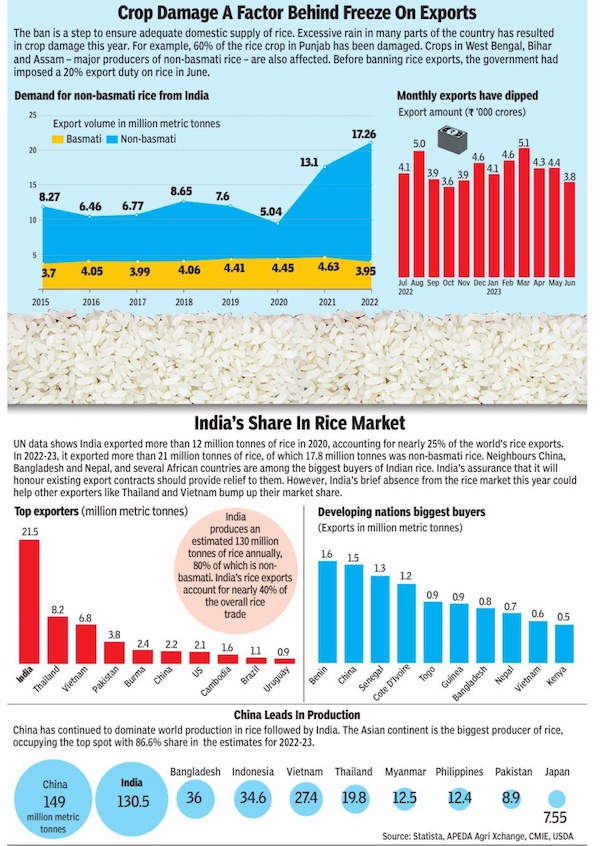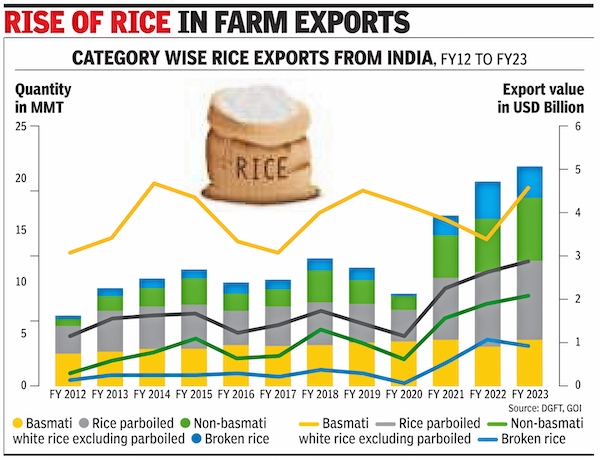Rice: India
This is a collection of articles archived for the excellence of their content. |
Contents |
Basmati
The GI tag issue
As in 2021, India vs Pakistan
June 28, 2021: The Times of India
Allies turned foes to take on US firm
Pakistan and India started off as allies against a Texas-based company called RiceTec which tried to appropriate and patent Basmati rice In the 1990s. Indian agricultural scientists dug up historical records and found that basmati had been mentioned in a Punjabi poem called Heer-Ranjha written by Waris Shah in 1766 to contest the US company’s claim. Together, the two countries managed to thwart the company’s attempts.
Ice over rice
In 2018, India applied for a GI tag in the European Union so that it would get exclusive rights to export. Pakistan, which didn’t have domestic GI laws in place, had to wait till September 2020 to file a counter petition. It claimed that basmati initially grew only in Pakistan and India took seeds from it. It also used the Heer-Ranjha citation to bolster its case as the story was set in the town of Jhang, which is in Pakistan’s Punjab.
Why does the GI tag matter?
One country getting the GI tag would mean that they would have monopoly over basmati rice markets in Europe. For India, the GI tag would boost India’s basmati rice exports up to $500 million in a couple of years, according to estimates, which is double what is being exported to the region right now.
Will the feud be settled soon?
Now, some reports say that both countries are working on a way to share ownership for the product. That will settle another feud, and Europeans can continue to feast on biryanis and pulaos.
Basmati, Dehraduni
2018-22, 2024: 62% reduction in area sown
Shivani Azad, January 24, 2024: The Times of India
62% dip in Doon Basmati acreage in 5 yrs
Dehradun : The cultivation of the Dehraduni Basmati rice, renowned for its unique taste and aroma, has witnessed a drastic 62% reduction in the Doon valley in a span of just five years — between 2018 and 2022. A fouryear study commissioned by the Uttarakhand Biodiversity Board, whose report revealed that in 2018 Dehraduni Basmati was cultivated in 410.1 hectares by 680 farmers, which plummeted to 157.8 hectares by 517 farmers in 2022.
The study adds that “other basmati varieties, grown in 420.3hectares of land by 560 farmers, have also come down to 180.7hectares in 2022.” Factors affecting cultivation include increasing summer temperatures, poor soil fertility, reduced use of farmyard manure, water scarcity for irrigation, changing rain patterns, and extensive use of chemical fertilisers, according to the study.
The grain is noted for its distinctive flavour, akin to sandalwood and flowers, coupled with a slightly sweet taste, which made it stand out among the around 30 basmati varieties found in India.
Farmers cultivating the grain, long cherished for its non-waxy and non-glutinous characteristics, said that the special qualities of the basmati stemmed from a combination of soil, water, climate, and cultural practices, which are now under threat.
The main area where the rice has been cultivated — Seola-Majra — has transformed into a concrete jungle, lamented a farmer. “Unplanned development has swept away the Dehraduni Basmati from many fields. We could still salvage it in remaining areas if all the anthropogenic concerns are addressed effectively,” said Jaswant Negi, a veteran farmercum-rice miller from Majra.
The trend of declining Dehraduni Basmati rice cul tivation goes back to 1997 when several places like Seolakalan, Brahamanwalaa, Seola Khurd, and Pitthuwala, once cultivating the grain abundantly, began to have shrinking fields. They now have only a few hectares of cultivable land left.
Dhananjai Mohan, chairman of Uttarakhand Biodiversity Board, said, “Through the study, we identified factors responsible for the dip in cultivable area of the grain. A framework has also been made for promoting Dehraduni basmati among farmers.”
Meanwhile, in a ray of hope, a few entrepreneurs are reviving basmati cultivation, especially organic basmati, in parts of Doon and Uttarakhand. “We have earmarked a few acres of land in Vikasnagar on the outskirts of Doon to start with its cultivation,” said Devagya Singh, a former Hong Kong resident who has returned to the country, and taken up agriculture.
Exports
2015-21
Richa Gandhi, Sep 7, 2023: The Times of India

From: Richa Gandhi, Sep 7, 2023: The Times of India
India is the world’s second largest producer and biggest exporter of rice. So, its decision to stop the export of non-basmati rice has shocked the global food market. The ban, likely to last till the end of the paddy harvest season in November, could cause shortages, driving global food prices upwards, says Richa Gandhi.
2012 – 23

From: Ashok Gulati and Raya Das, July 31, 2023: The Times of India
See graphic:
Category wise rice exports from India, FY12 to FY23
New varieties
2020: Telangana Sona, fit for diabetics
HYDERABAD: Diabetics are generally told to avoid having large quantities of rice given that it is rich in carbohydrates. But a new variety of rice developed and cultivated by Professor Jayashankar Telangana Agriculture University may not only help in reducing blood glucose, it may also help in fighting cardiovascular diseases.
According to the researchers, the new variety — ‘Telangana Sona’ — has only 51.6% glucose when compared to other varieties which have between 55% and 62% glucose. Another important finding about this variety is that it has less carbohydrates than even millets, according to National Institute of Nutrition (NIN), Secunderabad.
A paper on Sona has now been published in a recent issue of the reputed American Journal of Food Nutrition as useful variety with low glycemic index (GI). The researchers say the variety is effective in reducing type 2 diabetes.
“In conclusion, it can be reported from the study that the low GI rice RNR 15048 can be useful therapeutic diet that helps in reduction of blood glucose and elevation in plasma HDL Cholesterol levels in patients with type 2 diabetes,” the paper states. Food low on GI release glucose slowly and steadily. Foods high on GI release glucose rapidly.
Sona was developed by the university three years ago along with another variety named after Bathukamma, Telangana’s floral festival celebrated during Dasara. “Since then, we have been promoting this variety. A few lakh hectares in Telangana have been converted into Sona cultivation,” professor Pravin Rao, vice chancellor of the university, told TOI. “I can say this is the most authentic diabetic-friendly developed in the country.”
Officials say that the variety is also farmer-friendly as it gives yield in very short span when compared to other varieties. Farmers can expect the yield within 120 to 130 days.